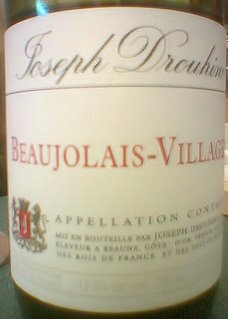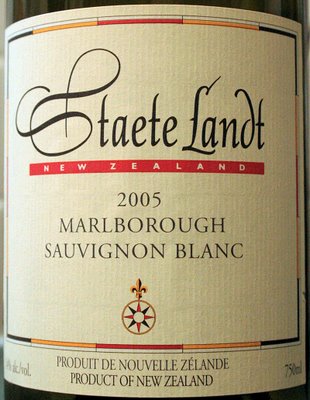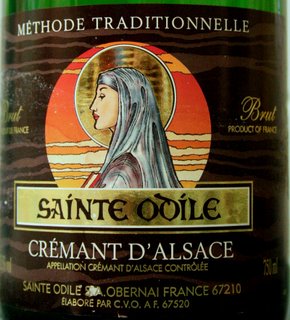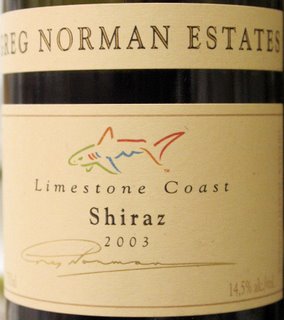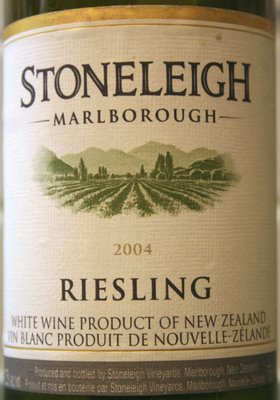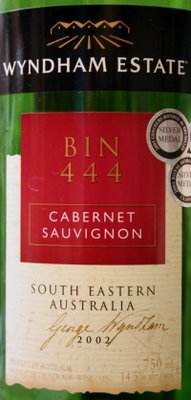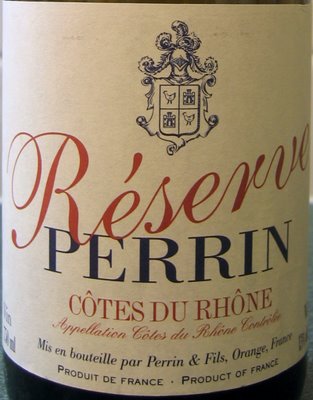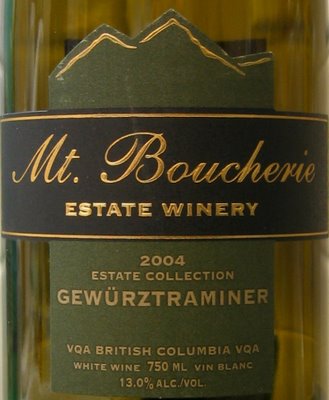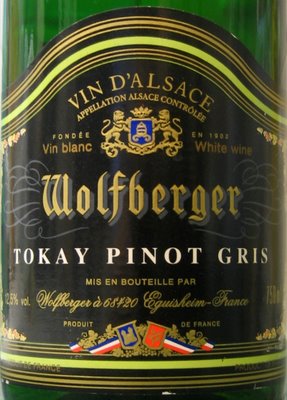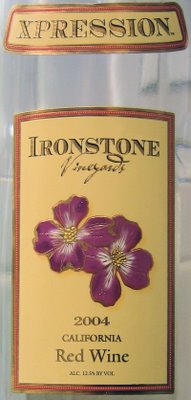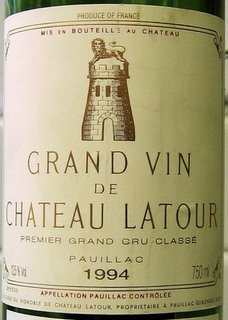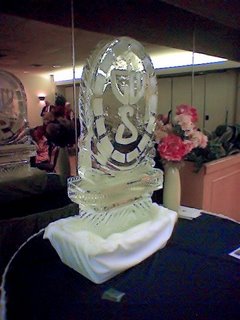
On March 5 the German Wine Society held a very special dinner at the Seven Oaks in Regina--not special because of the venue, so much (though the food was very good!) but because we were honored by the presence of Rainer Karl Lingenfelder of Germany’s
Lingenfelder Estate Winery, scion of a family that has been making wine in the Pfalz region of the Rhine Valley for 13 generations.
We're going to go through the evening’s food and wine first, then provide a full recounting of Lingenfelder's comments in a separate post.
The evening began, as such evenings are wont to do, with reception wines. The first was a 2001 Kirchheimer Schwarzerde Kabinett (Pfalz). Very nice, very typical, nothing remarkable, it made a pleasant reception beverage.
The second reception wine was a 2004 Gustav Adolf Schmitt Nierstiner Kabinett (Rheinhessen). We found this not quite as sweet as the Kirchheimer, and a bit more acidic. Margaret Anne suggested lychee as one of the flavours she detected. We liked this one a bit more than the first wine.
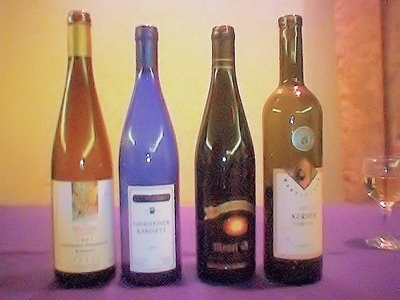 The food began to appear, starting with an "appetizer" that was almost big enough to be an entrée: Saskatchewan walleye in a puff pastry boat. With it came a 2003 Mosel Gold QbA (Mosel-Saar-Ruwer). This was a very pale wine with a citrusy nose and just a slight hint of that "hydrocarbon" smell that is typical of rieslings. It made a nice match with the appetizer.
The food began to appear, starting with an "appetizer" that was almost big enough to be an entrée: Saskatchewan walleye in a puff pastry boat. With it came a 2003 Mosel Gold QbA (Mosel-Saar-Ruwer). This was a very pale wine with a citrusy nose and just a slight hint of that "hydrocarbon" smell that is typical of rieslings. It made a nice match with the appetizer.
Rainer Lingenfelder commented that the Mosel Gold was richer than usual because there had been a very early flowering in 2003, which gave the grapes longer to ripen. In Germany, Lingenfelder, said, 2003 was a good year for whites, and an even better year for reds.
The soup came next: Consommé Celestine with Brandy. It was delicious, but not as hot as it might have been. Served with it: 2002 Lingenfelder Riesling Spätlese (Pfalz), our first taste of our guest's wines (which are not--yet--available in Saskatchewan). We found it very, very nice. Again, there was a touch of hydrocarbon. We felt it had a richer mouth feel than the previous wines.
Lingenfelder commented that with the earlier flowering that has become the norm in the last 15 years, possibly due to global warming, wines are reaching Pradikett level "without even trying that hard."
Someone asked if the riesling qualified as a halbtrocken ("half dry") to which the reply was no, because its residual sugar is too high.
Halbtrocken and trocken are defined by sugar and acidity levels, Lingenfelder explained.
For a wine to qualify as a halbtrocken the residual sugar can't be any higher than grams of acidity plus ten. For a wine to qualify as a trocken ("dry"), the residual sugar can't be more than the grams of acidity plus two.
Although in North America people think of German wines as inherently sweet, in Germany, Lingenfelder said, consumers actually prefer dryer wines. As a result, more dry German wines are sold domestically than are exported.
The Lingenfelder Riesling we tasted with the soup, which sells in Canada (where you can get it) for $20 to $25, doesn’t qualify as a halbtrocken, but it does have a nice acidity that keeps it from seeming too sweet, and that lingers on, leaving a fresh taste. Lingenfelder noted that the wine is beginning to develop secondary flavours.
Soup was followed by salad, which, of course, was not accompanied by wine. The salad, described on the menu as "Pea Shoot with Spring Greens," included a large doughnut-shaped crouton and a miso-flavoured dressing. Very nice!
The entrée, roast bison with a saskatoon berry reduction served on a wild rice croquette with root vegetables and butternut squash, was accompanied by two Lingenfelder wines: their 2002 Fox Label Dornfelder and their 2004 Hare Label Gewurztraminer Spätlese.
We found the Dornfelder to be very light and fruity, with not much bouquet. The Gewurztraminer was also very nice, and quite dry despite being a spätlese.
We felt the red went better with the bison, while the white went well with the wild rice and the squash but didn't quite work with the bison--making the pair of them, we guess, just about the perfect accompaniment.
Both of these wines, it's interesting to note, feature screw tops. Lingenfelder said that for wines intended for consumption within five years, and wines in which they want to preserve a fresh, young character, white or red, "the screw top is a sensible thing to do."
But, he went on, "With the estate-bottled wines, which can be aged 10 to 15 to 20 years, we've stayed with cork. You want a little oxygen to help with the aging of the wine."
All the Lingenfelder wines were relatively low alcohol, in the 10 to 12 percent range generally. Asked about alcohol levels, Lingenfelder said he felt winemakers have been going overboard with high alcohol levels because judges praise high-alcohol wines in competitions.
"We cannot compete in making high alcohol wine anyway, so we carved out a little niche for ourselves in offering something different, a lighter-style wine," Lingenfelder said. "Everyone is experiencing these hot, big monster red wines. There's a counter-current starting to happen. People are getting a little tired of being tired after drinking wine. Luckily the world of wine is so diverse and so interesting there's room for different shades and different colours and different flavours."
There are still plenty of people in North America who are surprised to find out the German reds like the Dornfelder even exist; but in fact, as Lingenfelder pointed out, a third of the wine produced in Germany is red. "Red wine is highly fashionable in German, very much sought after, in parts very very expensive," Lingenfelder said. Although his family has always made red, he noted, they're now making a little more than they used to.
Dornfelder is a relative newcomer to the wine world; the grape was only developed 50 years ago or so. A wine that has a much longer history in the Pfalz region, Lingenfelder said, is the Gewurztraminer.
"It's been in the Pfalz at least for 400 years, probably longer, as it is in Alsace (literally next door to the Pfalz, in France). We have a similar mix of grape varieties." Riesling continues to be the most important of those, he said, but Gewurztraminer and Scheurebe, "another very spicy grape variety" are also widespread.
The Gewurztraminer served with the entrée is very interesting, Lingenfelder said. It's dry, with just a couple of grams of residual sugar, but it still comes across as round and soft. Because it is a Spatlese, despite its being so dry "you taste the ripeness," he said.
Lingenfelder also pointed out something else interesting about the Gewurztraminer grape: it's one of the few varieties you can recognize by flavour. "Riesling gets it flavor from the fermentation, but Gewurztraminer does have its natural spice flavor from the grape to some extent.”
Dessert was Poached Pears Victoria (pears poached with strawberries), accompanied by a 2003 Martinshof Kerner Spatlese (Pfalz). The wine was very nice by itself--we've liked every Martinshof wine we've tried--and surprisingly good with the dessert; the acidity was sufficient to cut through the cream.
According to the menu, that was the final wine we would be tasting--but Lingenfelder had a special surprise for us: a 2003 Trockenbeerenauslese that, at 240 oechsle (a German method of measuring specific gravity, and hence sugar content, in grape juice before fermentation, that’s similar to the Brix method used in the U.S.), was the highest the family has every achieved. Wines with that much sugar (it's around 40 percent!), even higher than in ice wine, can be too syrupy--but not this time.
Lingenfelder made only two beer kegs of this wine (and as a result, it sells for $300 a half bottle). He has been trying to spread it among as many people as possible. We each got exactly five ml, distributed by pipette. That was just a few drops each, but it's so rich a few drops is sufficient (although all of us would have been happy to have a few more--Margaret Anne used her finger to get every last drop out of her glass!).
"It's unbelievable you can drink something like that," Lingenfelder said, and that it has "so much flavor, so much aroma, so much acidity."
It's only 6.5 percent alcohol and, in fact, Lingenfelder said, they had to really struggle to ferment it, especially since Lingenfelder takes an all-natural approach to winemaking, eschewing adding yeast or even yeast nutrients. "We stir the ferment and we warm it," he said. "We keep it above 25 C, so we usually take it into our kitchen. Quite often we put it in a water bath, and in the water bath we have a heater and a thermostat. We stir it. It was a struggle to get the alcohol in it, it took some time."
Such high sugar levels in the grape would be impossible if not for a happy accident of nature known as "noble rot."
"The grape itself or the vine itself cannot deposit that much sugar in the grape, the osmotic pressure would be far too high," Lingenfelder said. "So there have to be other factors which come into play. We have to somehow get the water out and concentrate everything else.
"There are two methods of doing that: a dry concentration process or a freeze concentration process. (In) a freeze concentration process, as happens in ice wine, you freeze the juice in the berry."
Not that the juice really freezes: instead, the water molecules form crystals, concentrating the remaining juice and sugar...and since sugar acts as an antifreeze, the more concentrated the sugar the lower the freezing point of the water it's dissolved in.
However, that wasn't how the Trockenbeerenauslese was made: for it, Lingenfelder used a dry concentration process, essentially turning the grapes into raisins. Instead of the water freezing out, it evaporated, leaving behind juice that was sweeter and more concentrated.
The resulting "raisins," however, were not like the familiar Sultana raisins which shrivel in the heat. "We need a little helper to permeate the skin, to make little holes in the skins of the berries, and then the sun shines on the berries and the water evaporates quickly. This little helper is called noble rot, or botrytis. It is a fungus. It grows in the skin and permeates it, makes little holes. It not only makes little holes so that the water evaporates, it also leave traces of its own aroma. The honey aromas you get in there are partially botrytis. This fungus grows on the berries, covers it all. It looks rotten, but the result, as you can see is liquid gold."
It's similar to truffles, he said. "Truffles look rotten, they come from the earth, but they are gold you can eat, and this is gold you can drink."
He was right about that. The wine had a gorgeous bouquet, absolutely beautiful, and a gorgeous flavour, too. The comment at our table was, "Better than any ice wine."
All in all, a fabulous evening of food and wine. We look forward to someday having Lingenfelder wines in Saskatchewan liquor stores--and to having Rainer Lingenfelder as a guest at another German Wine Society event in the not-too-distant future.
For more on what Rainer Lingenfelder had to say, read the next post!
